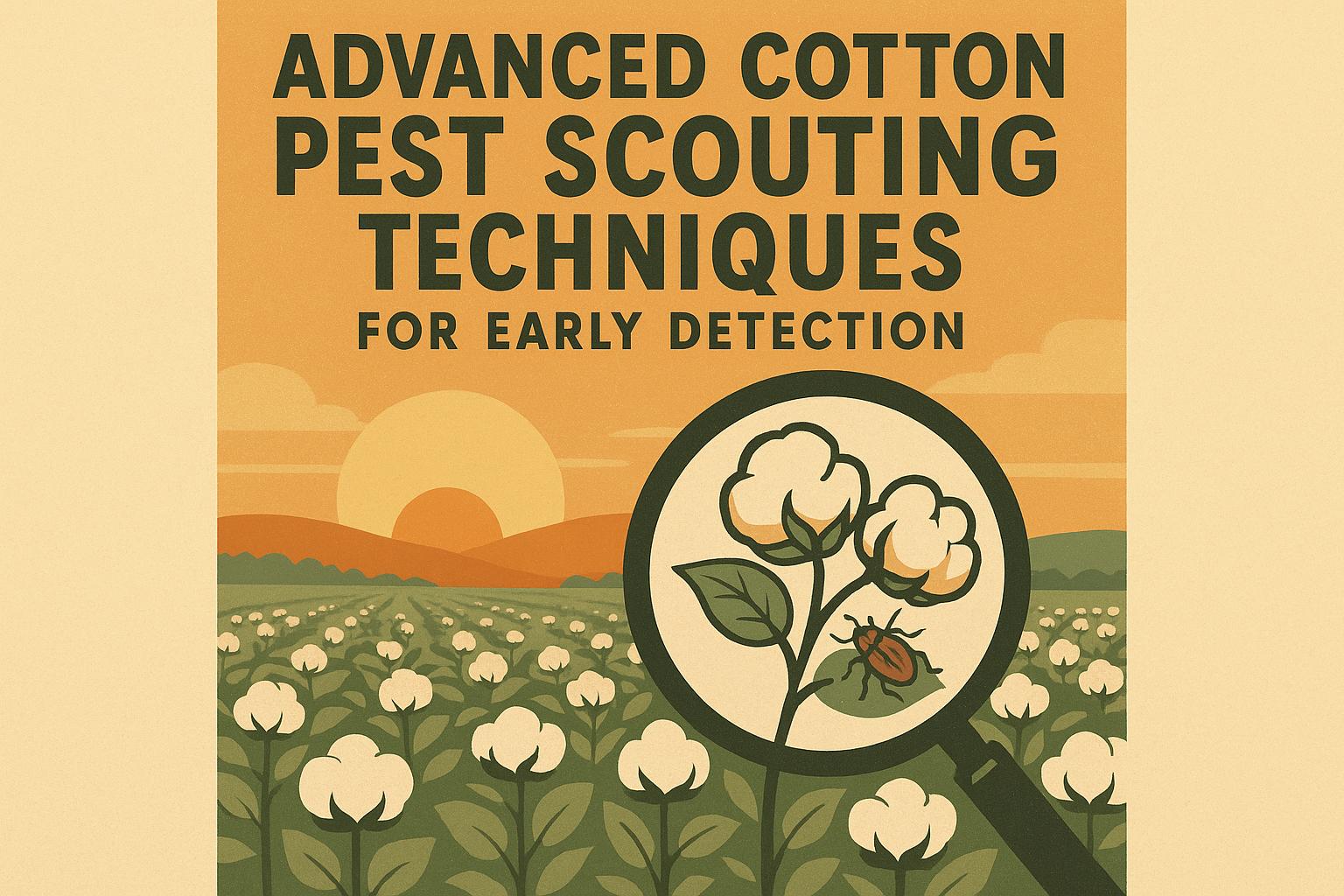Executive summary (TL;DR)
- Tackle early-season pests in cotton by scouting at emergence and using thresholds like 2-3 thrips per seedling—integrate seed treatments to cut stand loss 20-30% without blanket sprays.
- Rotate modes of action for aphids and plant bugs; layer Bt varieties with beneficials to slash apps by 15-25% while protecting beneficial insects.
- Monitor soil for cutworms and wireworms pre-plant; use baits in high-risk zones to boost establishment and yields up to 10% in infested fields.
Related Post: For more on targeted insect control, check out our post on Cotton Thrips Management.
If you've been growing cotton for a while, you know that early-season pests can set the tone for the whole year—get ahead of them, and your stands thrive; let them linger, and you're chasing problems till harvest. We're talking thrips twisting leaves, aphids sucking sap, or cutworms clipping seedlings at the soil line. It's not just about spraying; it's about smart timing, thresholds, and integration that fits your operation without emptying the tank mix budget. I've seen fields where a quick scout saved thousands in replants, and others where ignoring early signs led to thin stands and weak yields.
This isn't beginner stuff—you've handled your share of scouting and treatments. Here, we'll dig into strategies for managing early-season pests in cotton, pulling from extension data like Texas A&M and Mississippi State trials. No fluff, just what works in the field: from identification to IPM layers that keep costs down and efficacy up. Let's break it out, pest by pest, with the tools to make your program tighter.
Why Early Season Matters More Than You Think
Cotton seedlings are vulnerable—slow to emerge, with tender tissues that pests love. Damage here hits root development, delays squaring, and can drop yields 10-20%, per NCSU studies. Thrips alone cause 5-15% losses in untreated fields across the Belt.
But it's not all doom: Proactive management boosts vigor, closes canopy faster for weed suppression, and sets up for better boll set. A Georgia extension report showed integrated approaches cut insecticide use 20% while holding or improving yields. For your bottom line, that's real money—fewer passes, less product.
Key window: Emergence to first square (V1-V6). Scout twice weekly; thresholds guide action, not calendar.
Thrips: The Stand Stealer
Thrips top the early list—western flower, tobacco, and onion varieties all hit hard. Symptoms: Silvering, crinkled leaves, and terminal bud death. Heavy infestations stunt plants, delay maturity by 7-10 days.
Threshold: 2-3 per seedling with damage; 1 per plant under stress (cool/wet).
Strategies:
- Seed treatments: Neonics like imidacloprid or thiamethoxam provide 21-28 days protection. Arkansas trials: 90% control vs. 60% foliar alone.
- Foliar follow-up: If thresholds hit, acephate (0.25 lb/acre) or spinetoram. Rotate MOAs—Group 4A to 5—to dodge resistance.
- Variety choice: Some like Deltapine lines show partial tolerance; stack with treatments.
Personal note: I once skipped treatment on a cool spring edge field—lost 10% stand. Now, always scout borders first.
Table from extension guidelines:
| Pest Stage | Threshold | Treatment Options | Efficacy Notes |
|---|---|---|---|
| Pre-emerge | History of infestation | Seed treat + at-plant | 80-90% prevention |
| 1-2 leaf | 2-3/plant | Acephate foliar | Quick knockdown |
| 3-5 leaf | 1/plant + damage | Spinetoram | Longer residual |
Aphids: Sap Suckers Building Fast
Cotton aphids explode post-emergence, especially in lush growth. Black sooty mold from honeydew flags them; curled leaves, stunting follow.
Threshold: 50/leaf pre-bloom; lower if virus risk.
Management layers:
- Beneficials first: Ladybugs, lacewings devour them. Avoid broad-spectrum early to preserve—flonicamid (Group 29) targets without flare-ups.
- Seed/foliar: Imidacloprid seeds help, but monitor for resistance. Sulfoxaflor if needed.
- Cultural: Balanced N avoids excess vigor attracting them. Oklahoma State: Rotations with sorghum cut populations 30%.
Trials show IPM with beneficial releases + thresholds reduces sprays 25%.
Plant Bugs: Tarnished Troublemakers
Tarnished plant bugs (TPB) migrate early, piercing squares for sap. Dropped squares, pinhead bolls signal them.
Threshold: 8-15/100 sweeps pre-bloom.
Tactics:
- Scouting tools: Sweep nets or drop cloths—check 25 row-ft spots.
- Chemistry: Novaluron (IGR) for nymphs; mix with acephate for adults. Rotate to avoid resistance.
- Borders matter: Mow weedy edges; trap crops like alfalfa draw them away.
A Texas study: Border sprays alone cut field-wide apps 15-20%.
Cutworms and Wireworms: Soil Lurkers
Cutworms clip stems at night; wireworms bore seeds/roots.
Pre-plant scout: Dig 1 sq ft samples; threshold 1-2 larvae.
Approaches:
- Baits: Chlorpyrifos granules in-furrow for cutworms.
- Seed treats: Clothianidin for wireworms—80% control in sandy soils.
- Tillage: Fall plowing exposes them; covers like rye suppress.
Mississippi data: Treated seeds + scouting = 10% yield bump in history fields.
Flea Beetles and Other Biters
Flea beetles riddle leaves; grasshoppers chew edges.
Threshold: 25% defoliation pre-square.
Control: Pyrethroids (Group 3A) if over; but spot-treat to save beneficials.
Integrating IPM: The Big Picture
No pest fights alone—layer for synergy. Start with resistant varieties (Bt for lepidopterans), cultural (rotations, timely plant), biological (preserve predators), then chemical last.
NCSU model: IPM cuts early inputs 20-30%, yields up 5-10%.
Tech aids: Apps for thresholds; drones spot hot zones.
Resistance Management: Stay Ahead
Rotate MOAs yearly—thrips resistance to neonics rising. Track with bioassays via extension.
Economics and ROI
Early control costs $10-20/acre; saves $50+ in yields/replants. Calculate: Infestation risk x loss potential.
Troubleshooting Flare-Ups
Flare after spray? Check coverage, weather. Predators gone? Switch selectively.
Long-term: Soil health via covers reduces pressure.
I've refined over the years: Scout hard, threshold strict, integrate all. Turned pest headaches into minor tweaks.
Actionable Takeaways
- Scout twice weekly V1-V6; use thresholds like 2 thrips/plant to trigger.
- Layer seed treatments with foliares; rotate MOAs for resistance.
- Preserve beneficials with selectives; cultural like rotations cut 20-30%.
- Track costs/yields; adjust yearly for 10-15% efficiency.
How do you handle early pests?


